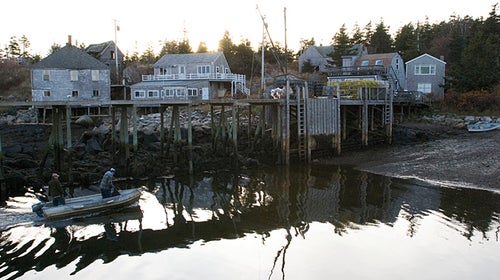Around 10 A.M. on July 20, 2009, a slight breeze started to pick up on Matinicus Island, Maine, the most remote inhabited island on the eastern seaboard. Alan Miller eased his sleek lobster boat, Hustler, past the rock breakwater and into the sheltered harbor. Although Miller had a permit to lobster the crustacean-rich seafloor surrounding Matinicus, islanders had made it known that the mainlander wasn’t welcome.
Matinicus Island
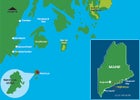
R.K. Ames on Matinicus Island
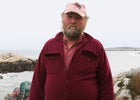 Longtime Lobsterman R.K. Ames on Matinicus Island
Longtime Lobsterman R.K. Ames on Matinicus IslandClayton Philbrook
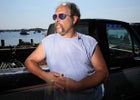 Clayton Philbrook speaking to the press.
Clayton Philbrook speaking to the press.Vance Bunker
 The shooter, Vance Bunker
The shooter, Vance BunkerMatinicus Island
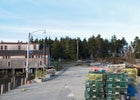 The site of last summer's feud: the wharf on Matinicus Island
The site of last summer's feud: the wharf on Matinicus IslandAbout a month earlier, Miller, a wealthy 60-year-old lobsterman with a second home on the island, had chosen to ignore the islanders’ unofficial decree and boldly set 400 traps, valued at $20,000, in Matinicus waters. Two weeks after, he discovered that about half of his wire-mesh pots had been cut free from their buoys and heard rumor that Weston Ames and Chris Young, two forty-something stepbrothers and Matinicus residents, hidden by fog, had snipped his lines. Reportedly, Ames and Young soon found some 400 of their traps knifed—and suspected Miller, of course.
Earlier on the morning of July 20, Young had tried to force a confession out of Miller’s 69-year-old father-in-law, a longtime Matinicus lobsterman named Vance Bunker. According to court documents, Young had illegally boarded Bunker’s boat and accused him and Miller of molesting his gear. The argument escalated. They ended up wrestling, then Bunker pepper-sprayed Young in the face.
A couple of hours after the fracas, the stepbrothers sought out Miller while he was hauling traps off Matinicus. According to Miller, they intercepted his boat and, supposedly just inches from bumping rails at 30 miles per hour, tried to run it aground on the shallow rock ledges. Miller managed to escape, but he suspected that the stepbrothers might be waiting for him back on Matinicus. As a precaution, he decided to radio the Marine Patrol and inform them of the situation. Ultimately, one of their officers decided to board Miller’s boat and accompany him to the island, where, hiding belowdecks, the officer might overhear Ames or Young make threatening remarks or confess to vandalizing Miller’s traps.
All seemed to be going according to plan when Miller approached Matinicus’s cement wharf around ten. The stepbrothers, as predicted, were waiting for him at the edge of the dock. As soon as Miller tied off, Ames and Young began spouting accusations, calling him names, and pounding on the canopy of his pilothouse.
Unbeknownst to Miller, however, his wife, Janan, and father-in-law were about to screw things up. From the window of the home that the Millers own on Matinicus, Janan had seen the men waiting for her husband and decided to take matters into her own hands. She had grabbed a shotgun from the bedroom and run down to the wharf. Bunker was also enraged. Still smarting from his earlier altercation with the stepbrothers, he and his deckhand (or sternman, as they’re called on lobster boats) were bouncing toward the showdown in a blue pickup with a heavy arsenal: a .22-caliber revolver, a .45-caliber handgun, and an AK-47 assault rifle with nine loaded clips.
As the shouting between Miller and the men grew louder, Janan arrived with her 12-gauge and leveled the barrel at the stepbrothers.
“Hey,” she barked.
“Shoot me, you stupid bitch,” Ames purportedly replied.
Miller yelled for the Marine Patrol officer, who was still hiding. Bunker, who had skittered onto the scene moments earlier, stepped onto the pier. When Ames made a move toward Janan’s shotgun, Bunker cocked his .22 and fired at him. The bullet whizzed past his head.
“Dumb fuck, you missed me,” Ames taunted, according to Bunker. Ames instead says he pleaded, “Wait a minute!”
Ames then allegedly lunged at Bunker, who fired again, this time at Young, who collapsed at Ames’s feet. The bullet had struck him in the left side of his neck and would leave him partially paralyzed on his left side.
The entire altercation had lasted only a few minutes, but rumors of a possible showdown had already made their way around the tiny, two-square-mile island. Many of its 47 residents, some of them allegedly armed, had descended on the wharf en masse. The Marine Patrol officer finally made it into the open, pointed his service revolver at Bunker, and told him to stand down.
A TYPICAL WORKING lobsterman is thickset, clean-shaven, and red around the jowls and lives in a modest inland home; he doesn’t need to live beside the coast like some part-timer from “Mass-a-two-shits.” He never harvests egg-bearing females or undersize juveniles, honoring regulations that are nearly impossible to enforce, and is proud that the lobster population in the 36,000-square-mile Gulf of Maine might be the healthiest, most sustainable fishery in the world. Whether he’s a successful “highliner,” who can afford to party away the late-winter off-season in the Caribbean, or a “dub,” who doesn’t know how to move his gear to follow the critters’ migrations, he values hard work.
In a single year, the very best captains can harvest 100,000 pounds of soft- and hard-shell lobsters. This puts a couple hundred grand in each of their pockets and spurs on the state’s $250 million lobster industry. When they motor out to hunt sea bugs in the July-to-November high season, quite a few are packin’ heat.
Altercations in the 350-year-old fishery are nothing new, of course. As social anthropology professor James M. Acheson revealed in his groundbreaking 1988 book, The Lobster Gangs of Maine, fishing for the crustaceans is a low-grade turf war, with the delicious invertebrates as the drugs. (The disputes also inspire good fiction, as Elizabeth Gilbert’s first novel, Stern Men, demonstrates.)
While lobstermen don’t necessarily think of themselves as gangs, and few people commonly refer to them as such, that’s essentially what they are: informally organized groups of men from rivaling harbors. (Few women lobster.) The guys based out of nearby Monhegan Harbor, for example, are simply known as “the Monhegan boys” or “the Monhegan fishermen.” Most members come from long-established Maine families, live in the same town, keep their radios on the same channel, and help each other out if, say, a prop shaft breaks. When disputes arise, members generally follow the lead of the best and most magnanimous lobsterman in the harbor, though some harbors make collective decisions in regular, private meetings. For the most part, they interact only with the nearby competition; the only thing the Georges Islands gang might know about the roughly 200 other gangs along the Mid Coast is where their own turf abuts the Bremen boys’ and overlaps with the Pleasant Point punks’.
While gangs occasionally host cookouts or raise money for charity, one of their main functions is to “defend their bottom”—i.e., guard the seabeds where they drop their pots. Informal and long-standing lobstering boundaries, often referred to as “imaginary lines,” crisscross the Gulf of Maine like a spiderweb. Landmarks and dividing lines used to be handed down by word of mouth—e.g., “from the Western Pollock shoal at the 30-fathom mark, head toward the Hogshead lighthouse…” Now, lat-long coordinates are simply programmed into onboard GPS units. The state doesn’t recognize these imaginary lines or give them any legal weight, but defending and respecting them has become an honored tradition. Competitors will set their buoys within ten feet of each other without problems, but if a lobsterman from Boothbay crosses into the area claimed by South Bristol, then, well, things happen.
“That’s the exciting part of the business,” enthused Ryan Post, a fourth-generation lobsterman I met one sunny afternoon at the Port Clyde lobster feed. “We have to fight for what we got.”
Traditionally, fighting rarely if ever results in bloodletting. And it usually stays at sea. (“What happens on the water stays on the water,” the old red-clawed maxim goes.) First, the interloper is often verbally warned, then telltale knots might be tied in his buoy lines, lobsters stolen, threatening notes left inside bottles, lines cut, or traps even flattened with a sledgehammer or carved up with a chainsaw.
Over the past two years, however, the retaliations have grown progressively more severe. Shotguns have been brandished, boats surrounded. Traps have been cut almost daily; a stack was torched in a man’s yard. One boat was doused in gasoline and set ablaze on its mooring ball. Two others—their engine intake hoses cut—were sunk to the muddy bottom. Atop this steepening curve of violence stands the Meltdown on Matinicus, the first time in memory that a trigger was squeezed.
Initial newspaper reports suggested the economy spurred the gun show. A few years ago, lobstermen were discussing their investment portfolios on the VHF. Now wholesale lobster sells for $3 a pound, roughly half the peak price in 2005. Lobstermen are scraping by and on edge. They were looking for fights, the papers suggested.
Others blamed Matinicus, an isolated fist of rock 20 miles east of Rockland, where legend has it the last resident cop was run off 20 years ago by a cheering mob. And off the south shore of which, for a week after the July 20 incident, a couple of Coast Guard boats were anchored, to protect the peace. Without the civilizing influences of police, summer folk, and regular ferry service, the island’s residents—many descended from just three families—have been practicing a form of renegade justice so long that Matinicus has earned the nickname Pirate Island.
“They have their own systems and norms out there,” said a government employee who wished to remain anonymous. “You’ll see brothers clubbing each other in the mud at low tide with oars. Over what? Who knows?”
While many details of the incident remain murky, Vance Bunker was ultimately charged with two counts of elevated aggravated assault; Janan Miller with reckless conduct; and Chris Young and Weston Ames with criminal trespassing, among other infractions. The trial wouldn’t hit Knox County Superior Court until the spring, but I couldn’t wait that long to go to the island and ask a simple question: What the hell is going on?
NOT LONG AFTER reaching Rockland, in the Mid Coast area, in November, I rang Alan Miller up. He wasn’t home, Janan cheerily informed me, before telling me that neither of them would talk about the shooting without first consulting their lawyers. But, she politely offered, had I tried her father?
While awaiting trial, Bunker was living in his home on the mainland, near Rockland. Not two hours later, I pulled into the driveway of a tidy red shake house with a short-cropped lawn. Bunker is a huge man, six-one and 265 pounds, and wore heavy-duty suspenders and begrimed work pants. Even at 69, stiff with arthritis, hard of hearing, and facing up to 30 years in prison, he still hauled traps every other day. He was raised on Matinicus by a rum-running dad, has been “buggin'” all his life, and made headlines one frostbitten winter for the daring rescue of the crew of a sinking tug. Everyone I’d talked to respected him. Except, I soon learned, the parrot.
Perched on a hoop in the living room was a battery-powered bird that squawked when its motion sensor was triggered. “Who’s a fucker now?” it asked mercilessly. We sat at the laminated breakfast table. Bunker spoke quietly and sometimes rubbed his fingers in his palms. The reason Miller wanted in, he explained, was simple: The lobstering around Matinicus was exceptionally good. While Miller wasn’t expecting balloons and a welcoming party, he figured they’d at least tolerate him.
“It was only a couple or three that was upset or pissed off about Alan,” Bunker claimed.
As Bunker continued, his wife, Sari, appeared with a roast chicken. “It’s a Dodge City mentality,” she opined.
The lobstermen of Matinicus, Bunker continued, had been debating what to do about Miller since he started dating Janan, a Matinicus native, in 2000. He was usually just one of many items they discussed in the island’s one-room schoolhouse or in the damp basement of the Congregational church. Bunker, who attended only some of the meetings, declined to share any specifics, but a rare 2007 court document, given to me by a source who wished to remain anonymous, allows us to imagine it.
The three-page photocopy, entitled “Matinicus Island School Lobster Meeting/Clown Show/Clusterfuck,” is from a meeting in June 2003. It may be the only tangible evidence of such gatherings to surface in 350 years of lobstering, and it includes telling items like “#5: Are we going to allow someone to fish two boats and sets of tags?” This despite the well-known state law that every lobsterman use only one boat and one set of licenses.
A subsequent agenda item raises the issue of a neighboring gang lobstering beyond its bounds: “What’s going to be done about the Criehaven punks pushing the line and who is really going to do what?” Another page lists the names of three people who wanted to lobster around Matinicus. (Miller wasn’t seeking permission at the time.) Everyone was asked to circle “Yes” or “No” and bring their opinions to the meeting.
Decisions made at such meetings are legally meaningless, as was the islanders’ eventual choice to deny Miller access to their lobstering territory. But it’s the way things are done. Bunker doesn’t have any problem with that. What irked him about the rejection of his son-in-law was the apparent change in the rules for joining the gang. In the past, he said, an island home and family legacy was all that was required to earn the right to harvest lobsters around Matinicus.
“I figured he’s got as much right to fish out there as about 15 other families,” said Bunker.
“The whole island is full of incest,” Sari offered.
As dusk fell, Bunker became even more forthcoming about the island’s insular politics, which other sources would later corroborate and expand upon. Bunker and the stepbrothers, including the one he shot, had been friends for decades, it turned out. And while I would later learn that Weston Ames had been convicted of sexually assaulting a minor in 1993, the general consensus was that he’s basically a decent guy. Few lobstermen had kind words for Miller, though. They alleged that he had amassed a fortune by taking advantage of the loophole in the law that allowed you to fish two boats, and was unliked even in his home port of Spruce Head. As one Matinicus lobsterman would later put it, “We have enough assholes of our own. We don’t need to import more.”
I finally decided to ask the question I’d worn on my chest like a sandwich board since arriving: “Why did you shoot?”
“I can’t tell you,” he replied, looking hangdog. “I was scared. Afraid.”
HE WASN’T THE ONLY ONE. Although I heard a few idyllic anecdotes about life on Matinicus, most were ominous.
Like the one about a bitter ex-resident, nicknamed Uncle Knifeblade, who tossed ashore a passel of hungry, nonnative raccoons. Or the sternmen who arrived each summer, heroin addictions in tow. Or the one about the island’s fire chief, “Rambo,” normally an upstanding member of any community, threatening a fellow islander with nunchucks. Or the axes swung through car windshields. Or the lobsterman stabbed in the chest with a kitchen knife, for allegedly burning down his assailant’s house.
While it was clear that the incidents had taken place over the course of many years, the savage rumors still cast a long shadow. Plus several people had warned me, “You go out there, no one’s gonna talk to you.”
Indeed, Ames and Young had retreated behind a shroud of loyal friends and changed-number notices. Even the island’s self-appointed spokesperson to the press, Clayton Philbrook, and his friend Nat Hussey, a supposedly affable former lawyer who recently moved to the island to practice guitar and work as a sternman, didn’t call me back right away. (Although I did stumble upon Hussey’s surprisingly excellent lobster-rock video, “Haul ‘Em Up,” which you can watch on YouTube.)
The only person whose number I had but didn’t dial was Ames’s 69-year-old father, R.K. Ames. The supposed “kingpin of the cartel,” according to one local, was the only islander I had been specifically warned not to cross. So I started off by doing as much snooping as I could on the mainland. I wandered around the Journey’s End Marina, in Rockland, where Young’s $250,000 lobster boat was on blocks, up for sale. A workman with a burn-swirled half-face claimed he didn’t know anything at all about the incident.
Lobster wholesalers, neighbors of those involved, the officers at Marine Patrol headquarters—people either didn’t want to talk or had nothing informative to add. In a darkened office one drizzly afternoon, I had an off-the-record conversation with a trap builder who began by summoning his mute secretary to bring us black coffee in styrofoam cups and finished with vague, unhelpful allusions. A visit to the Knox County Courthouse, in Rockland, one rainy morning was equally unfruitful. Convictions and complaints about the assailants and victims were minor and random—hunting without orange clothing, drunken boating, threats to destroy septic fields. I was learning very little but growing unduly, conspiratorially suspicious nonetheless.
One evening I attended a dispiriting gathering of the Lobster Advisory Council. The main topic was the severity of an upcoming shortage of herring, the primary bait used by lobstermen. Massive amounts of information were displayed in dizzying PowerPoint grids. Eyes glazed over behind wire-rim accountant glasses. New sustainable sources of inexpensive bait weren’t obvious, and attendees worried about lobstermen losing their livelihoods.
In the past four years, as demand dwindled and costs creeped higher, highliners and dubs alike had seen their incomes drop by almost half. If the price of bait doubled, or if bait wasn’t available, due to new laws restricting the amount of herring you can catch, one of Maine’s few great economic engines—a billion-dollar industry, once you factor in all the multipliers—was likely going to implode. The phrases “Hail Mary” and “Take it on the chin” were repeated.
“It’s gonna weed guys out,” predicted a somber attendee, “especially those who live on islands.”
The only bright spot was that, through a connection at the meeting, I was finally able to track down Chris Young, who’d been in and out of the hospital. He was irate to learn that I’d been given the unlisted phone number he’d switched to after the shooting. When I tried to explain myself, he cut me off. “You’ve talked to Vance?! This conversation is over,” he declared, and hung up. Twenty minutes later, his wife called, chewed me out for a few minutes, and hung up.
The next morning, after spending the night at the tony Camden Harbour Inn, I discovered that the front-desk attendant in the pressed polo shirt had sterned offshore for a couple of summers. “No one messes with Matinicus,” he declared, a note of awe and menace in his voice. I chuckled, a bit uncomfortably, and then slumped into an Adirondack chair on the wraparound porch overlooking the ocean.
Only a few moments later, as if on cue, a maintenance man strode by in a black hoodie featuring a graphic of an assault rifle, crosshairs, and the obscure but unmistakable words MATINICUS TACTICAL TEAM.
IN OCTOBER, A FERRY runs just three times a month to Matinicus. You can also pay to hitch a ride on the single-prop Cessna that delivers the mail most mornings or, for a few bucks more, simply hire a charter. After 15 minutes aloft, my air taxi touched down on the gravel airstrip. There were no other guests at the Tuckanuck Lodge bed-and-breakfast, just the eccentric old proprietor, a spartan room, and the included breakfast and dinner—but not lunch, which is odd when you consider that there isn’t a restaurant, grocery store, or even a coffee shop on the island.
I dropped my bag and walked past boggy pine forests over a knoll to the wharf. In the peaceful solitude, it was difficult to reimagine the crime. Just as I was about to leave, Philbrook and Hussey happened to step ashore in the dusky late-afternoon light. Philbrook handed me a plastic bag full of fresh lobster and invited me to his house for a beer.
“Every lobsterman who doesn’t fish Matinicus has to believe Matinicus lobstermen will cut his lines,” Philbrook explained, sitting at a living-room table strewn with electrical wires and other detritus. With only 39 lobstermen to defend a perimeter of imaginary lines that elsewhere might have 390, the more overblown the island’s pirate reputation, the better. The real secret, according to Philbrook and Hussey, was how amazing it was to live there. “I left twice last year, and it was two times too many,” said Hussey.
What they described did sound great. The one-room schoolhouse. Two-word addresses and four-digit phone numbers. A pervasive esprit de corps whenever the town pulled together during power outages or to rescue someone lost at sea. Everyone gathering at the church for the Christmas potluck, regardless of any differences, and singing carols and exchanging Secret Santa gifts. Stars so thick you’d think it was snowing.
A century ago, there were some 300 such inhabited islands in Maine, populated mostly by immigrant granite workers and Grand Banks fishermen. Now there are maybe a dozen, peopled by descendants of those Swedes and Italians and Canadians but with a frontier culture diluted by tourists and a real-estate market thrown out of whack by vacation homes.
If Matinicus was going to survive, Philbrook reasoned, every lobsterman who hauled traps around Matinicus needed to live, year-round, on the island. And according to him, that logic was at the center of the debate: Miller wasn’t allowed because islanders simply doubted he genuinely wanted to join the community. “His little place isn’t winterized,” Philbrook said.
It all made perfect sense. I put down my pad and pen, had another beer, and, half joking, ran through some of the crazy rumors I’d heard. When I told the one about the man being stabbed in the chest by a kitchen knife, Philbrook interjected.
“Well, that one’s true,” he said, shrugging casually and lifting his T-shirt to show his short pink scar.
PHILBROOK HAD INVITED me to go buggin’ with him the next morning, but bad weather turned us back at the dock, so I tried again to get in touch with a few other islanders. Most were either fishing or off-island or not where their fellow islanders told me they’d be, like in a white truck by the diesel-run powerhouse.
Running out of leads, I decided to try the infamous R.K. Ames. Even after I promised not to inquire about hidden beefs or the shooting of his stepson, he didn’t want to talk. Ten minutes later, however, he mysteriously changed his mind and called back. “I’ll give you a tour,” he said when he picked me up in a red, big-block Chevy dump truck.
Even by the outsize standards of a typically enormous lobsterman, Ames was a hulk. He wore a gold hoop earring in his left ear, à la Captain Kidd, a frayed, sun-faded ball cap, and a heavy chinstrap beard that gave him the scowling mien of a southern hanging judge.
We stopped first at the graveyard, where he’d already planted his own headstone in the grass. The marble slab, featuring a carving of his lobster boat, wasn’t far from that of Stephen Ames, a son who died of a heroin overdose, and Marina Ames, a relative who’d also OD’d. “We dig our own graves,” he explained. “This is how we live out here.”
Everywhere we drove, he narrated the stories of whichever relative had lived in whatever New England–style home we bounced past. “Is inbreeding a problem?” I ventured.
“We have two types of family trees: the flagpole and the wreath,” he said. “We don’t call it inbred; we say thoroughbred.”
He told me he owns some 15 pieces of property on Matinicus and the mainland. His gear collection, part of which I ogled in the hangar he calls his “toy box,” is just as impressive: 32 boats of varying size, a Piper Cub airplane, a 1977 Corvette, a full purse-seine fishing-net rig in a sawed-off school bus, a custom-built, Captain America–style panhead Harley chopper.
Ames was easy to like. He seemed to epitomize all the moxie, grit, and vigor of a Matinicus lobsterman. But he wasn’t so charming when it came to relations with living people. Ames women were either plump and faithful, like his lovely third wife, Emily, or skinny and promiscuous, like his daughter on the mainland, whom he wouldn’t talk to or support and repeatedly called a “slut.”
We admired his lobster boat, with its souped-up 400-horsepower engine and trim paint “the color of a teenager’s nipples.” Noting the skull-and-crossbones insignia on its prominent red riding sail, I asked about the Pirate Island reputation. “That’s a crock of shit,” he spat. Sure, islanders end up in a fair number of fights, but that’s just because, like fishermen across the world, they work too hard and drink too much. Anyway, the island polices itself just fine, he said. I wanted to point out that shooting a man’s son in the neck might not qualify as fine law enforcement, but I stuck to my word and bit my lip.
Visiting the sprawling house he was building for Emily—”new bird needs a new cage,” he explained—I went too far. I raised the allegation, unearthed while sifting through courthouse records, that he’d stolen this gently declining spread by the sea to make a backyard runway. One moment we were celebrating how he’d sealed his shingles by dousing them in a “secret sauce.” The next, he was standing stock-still, turning me into ice.
“My family has lived here for 200 years,” he growled lowly and evenly. “I don’t ask permission for much.”
We eventually made up over strong rum-and-Cokes back at the house, but I was still looking over my shoulder later that afternoon when I boarded the next plane out.
“It’s the Wild West,” a Rockland-based detective named Dwight Burtis would later tell me. “I think it’s probably more common that we don’t find out about incidents.”
IN MARCH, AFTER a four-day trial and ten hours of deliberations, Vance Bunker and Janan Miller were acquitted of all charges. (Chris Young—who has since regained some mobility and begun lobstering again—and Weston Ames pleaded guilty to trespassing and paid a small fine.) The eight women and four men of the jury, all from the mainland, found that the father and daughter had acted in self-defense—or, perhaps more accurately, it wasn’t proven beyond a doubt that they hadn’t acted in self-defense.
Bunker and his daughter both wept openly upon hearing the verdict. The stepbrothers chose not to be in the courtroom. They awaited the decision in the district attorney’s office, one floor below. After hearing the decision, they declined to talk to the press.
The next day, someone slashed all four tires of the truck Bunker kept parked at the Matinicus airstrip. Soon after, it was further vandalized with spray paint. Bunker has since returned a few times to his log cabin on Matinicus, but he and his wife now spend most nights at their home on the mainland.
Two months later, in an unrelated and little-publicized incident, two sternmen attacked another at his house in Matinicus, stole his pistol, threatened to break his hands off at the wrist, and left him with a smashed nose and a pummeled face.
